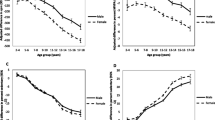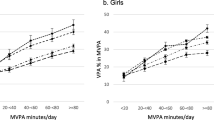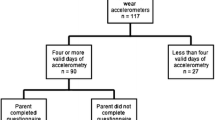Abstract
This study examined the concordance between accelerometry-measured and self-reported physical activity (PA) and sedentary time in adults with autism. Twenty-four participants wore an ActiGraph GT3X + accelerometer for seven consecutive days and completed the International Physical Activity Questionnaire-Short Form (IPAQ-SF) on the last day of their study participation. Bland-Altman plots assessed the magnitude of agreement between the two measures. Nearly 80% of the participants accumulated the recommended ≥ 150 min of moderate to vigorous PA (MVPA)/week, but were also sedentary for over nine hours/day according to accelerometry data. Findings showed that adults with autism tended to overreport MVPA (b = 1.606, p < 0.01) and underreport sedentary time (b = 1.161, p = 0.03) via the IPAQ-SF, as compared to objective measurements.


Similar content being viewed by others
References
Aadland, E., & Ylvisåker, E. (2015). Reliability of the actigraph GT3X + accelerometer in adults under free-living conditions.PloS One, 10(8), e0134606.
Bandini, L. G., Gleason, J., Curtin, C., Lividini, K., Anderson, S. E., Cermak, S. A., Maslin, M., & Must, A. (2013). Comparison of physical activity between children with autism spectrum disorders and typically developing children. Autism, 17(1), 44–54.
Bankoski, A., Harris, T. B., McClain, J. J., Brychta, R. J., Caserotti, P., Chen, K. Y., Berrigan, D., Troiano, R. P., & Koster, A. (2011). Sedentary activity associated with metabolic syndrome independent of physical activity. Diabetes Care, 34(2), 497–503.
Baron-Cohen, S., Wheelwright, S., Skinner, R., Martin, J., & Clubley, E. (2001). The autism-spectrum quotient (AQ): evidence from Asperger Syndrome/High-Functioning autism, males and females, scientists and Mathematicians. Journal of Autism and Developmental Disorders, 31(1), 5–17. https://doi.org/10.1023/A:1005653411471.
Bauman, A., Bull, F., Chey, T., Craig, C. L., Ainsworth, B. E., Sallis, J. F., Bowles, H. R., Hagstromer, M., Sjostrom, M., & Pratt, M. (2009). The international prevalence study on physical activity: results from 20 countries. International Journal of Behavioral Nutrition and Physical Activity, 6(1), 21.
Carson, V., Wong, S. L., Winkler, E., Healy, G. N., Colley, R. C., & Tremblay, M. S. (2014). Patterns of sedentary time and cardiometabolic risk among canadian adults. Preventive Medicine, 65, 23–27.
Cerin, E., Cain, K. L., Oyeyemi, A. L., Owen, N., Conway, T. L., Cochrane, T., Van Dyck, D., Schipperijn, J., Mitáš, J., & Toftager, M. (2016). Correlates of agreement between accelerometry and self-reported physical activity. Medicine and Science in Sports and Exercise, 48(6), 1075.
Choi, L., Liu, Z., Matthews, C. E., & Buchowski, M. S. (2011). Validation of accelerometer wear and nonwear time classification algorithm. Medicine and Science in Sports and Exercise, 43(2), 357.
Colombo-Dougovito, A. M., Blagrave, A. J., & Healy, S. (2020). A grounded theory of adoption and maintenance of physical activity among autistic adults. Autism, 25(3), 627–641. https://doi.org/10.1177/1362361320932444.
Craig, C. L., Marshall, A. L., Sjöström, M., Bauman, A. E., Booth, M. L., Ainsworth, B. E., & Oja, P. (2003). International Physical Activity Questionnaire (IPAQ): 12-country reliability and validity. Medicine & Science in Sports & Exercise, 35(8), 1381–1395.
Croen, L. A., Zerbo, O., Qian, Y., Massolo, M. L., Rich, S., Sidney, S., & Kripke, C. (2015). The health status of adults on the autism spectrum. Autism, 19(7), 814–823. https://doi.org/10.1177/1362361315577517.
Dietz, P. M., Rose, C. E., McArthur, D., & Maenner, M. (2020). National and State Estimates of Adults with Autism Spectrum Disorder. Journal of Autism and Developmental Disorders, 50, 4258–4266.
Dishman, R. K., Washburn, R. A., & Schoeller, D. A. (2001). Measurement of physical activity. Quest, 53(3), 295–309.
Dunstan, D. W., Howard, B., Healy, G. N., & Owen, N. (2012). Too much sitting - A health hazard. Diabetes Research and Clinical Practice, 97(3), 368-376. https://doi.org/10.1016/j.diabres.2012.05.020
Dyrstad, S. M., Hansen, B. H., Holme, I. M., & Anderssen, S. A. (2014). Comparison of self-reported versus accelerometer-measured physical activity. Medicine & Science in Sports & Exercise, 46(1), 99–106.
Eaves, L. C., & Ho, H. H. (2008). Young adult outcome of autism spectrum disorders. Journal of Autism and Developmental Disorders, 38(4), 739–747. https://doi.org/10.1007/s10803-007-0441-x.
Fennell, C., Lepp, A., & Barkley, J. (2021). Smartphone use predicts being an “active couch potato” in sufficiently active adults. American Journal of Lifestyle Medicine, 15(6), 673-681.
Freedson, P. S., Melanson, E., & Sirard, J. (1998). Calibration of the Computer Science and Applications, Inc. accelerometer. Medicine and Science in Sports and Exercise, 30(5), 777–781. https://doi.org/10.1097/00005768-199805000-00021.
Fuezeki, E., Engeroff, T., & Banzer, W. (2017). Health benefits of light-intensity physical activity: a systematic review of accelerometer data of the National Health and Nutrition Examination Survey (NHANES). Sports Medicine, 47(9), 1769–1793.
Garcia-Pastor, T., Salinero, J. J., Theirs, C. I., & Ruiz-Vicente, D. (2019). Obesity status and physical activity level in children and adults with autism spectrum disorders: a pilot study. Journal of Autism and Developmental Disorders, 49(1), 165-172.
Haegele, J. A., Zhu, X., & Bennett, H. J. (2021). Brief report: reactivity to accelerometer measurement among adolescents with autism spectrum disorder. Journal of Autism and Developmental Disorders, 51(8), 2996–3000.
Hagstromer, M., Ainsworth, B. E., Oja, P., & Sjostrom, M. (2010). Comparison of a subjective and an objective measure of physical activity in a population sample. Journal of Physical Activity and Health, 7(4), 541-550.
Hallgren, M., Owen, N., Vancampfort, D., Dunstan, D. W., Wallin, P., Andersson, G., & Ekblom-Bak, E. (2020). Associations of sedentary behavior in leisure and occupational contexts with symptoms of depression and anxiety. Preventive Medicine, 133, 106021.
Hollocks, M. J., Lerh, J. W., Magiati, I., Meiser-Stedman, R., & Brugha, T. S. (2019). Anxiety and depression in adults with autism spectrum disorder: a systematic review and meta-analysis. Psychological Medicine, 49(4), 559–572.
International Physical Activity Questionnaire Research Committee. (2005). Guidelines for data processing and analysis of the International Physical Activity Questionnaire (IPAQ)—Short and Long Forms. Retrieved January 10 (2018). from https://sites.google.com/site/theipaq/scoring-protocol
Jarrett, H., Fitzgerald, L., & Routen, A. C. (2015). Interinstrument reliability of the ActiGraph GT3X + ambulatory activity monitor during free-living conditions in adults. Journal of Physical Activity & Health, 12(3), 382–387. https://doi.org/10.1123/jpah.2013-0070.
Lee, D., Frey, G. C., Cheng, A., & Shih, P. C. (2018, September). Puzzle Walk: A gamified mobile app to increase physical activity in adults with autism spectrum disorder. In 2018 10th International Conference on Virtual Worlds and Games for Serious Applications (VS-Games) (pp. 1–4). IEEE. https://doi.org/10.1109/VS-Games.2018.8493439
Lee, P. H., Macfarlane, D. J., Lam, T. H., & Stewart, S. M. (2011). Validity of the international physical activity questionnaire short form (IPAQ-SF): A systematic review. International journal of behavioral nutrition and physical activity, 8, 115. https://doi.org/10.1186/1479-5868-8-115.
Lounassalo, I., Salin, K., Kankaanpää, A., Hirvensalo, M., Palomäki, S., Tolvanen, A., Yang, X., & Tammelin, T. H. (2019). Distinct trajectories of physical activity and related factors during the life course in the general population: a systematic review. BMC Public Health, 19, 271.
MacDonald, M., Esposito, P., & Ulrich, D. (2011). The physical activity patterns of children with autism. BMC Research Notes, 4(1), 422. https://doi.org/10.1186/1756-0500-4-422.
Mandell, D. S. (2013). Adults with autism—A new minority. Journal of General Internal Medicine, 28(6), 751–752.
Matthews, C. E., Keadle, S. K., Troiano, R. P., Kahle, L., Koster, A., Brychta, R., Van Domelen, D., Caserotti, P., Chen, K. Y., & Harris, T. B. (2016). Accelerometer-measured dose-response for physical activity, sedentary time, and mortality in US adults. The American Journal of Clinical Nutrition, 104(5), 1424–1432.
Migueles, J. H., Cadenas-Sanchez, C., Ekelund, U., Nyström, C. D., Mora-Gonzalez, J., Löf, M., Labayen, I., Ruiz, J. R., & Ortega, F. B. (2017). Accelerometer data collection and processing criteria to assess physical activity and other outcomes: a systematic review and practical considerations. Sports Medicine, 47(9), 1821–1845.
Milanović, Z., Pantelić, S., Trajković, N., Sporiš, G., Kostić, R., & James, N. (2013). Age-related decrease in physical activity and functional fitness among elderly men and women. Clinical Interventions in Aging, 8, 549.
Nelson, M. C., Taylor, K., & Vella, C. A. (2019). Comparison of self-reported and objectively measured sedentary behavior and physical activity in undergraduate students. Measurement in Physical Education and Exercise Science, 23(3), 237–248.
Pan, C. Y. (2008). Objectively measured physical activity between children with autism spectrum disorders and children without disabilities during inclusive recess settings in Taiwan. Journal of Autism and Developmental Disorders, 38(7), 1292.
Piercy, K. L., Troiano, R. P., Ballard, R. M., Carlson, S. A., Fulton, J. E., Galuska, D. A., ... & Olson, R. D. (2018). The physical activity guidelines for Americans. JAMA, 320(19), 2020-2028. https://doi.org/10.1001/jama.2018.14854.
Prince, S. A., Adamo, K. B., Hamel, M. E., Hardt, J., Gorber, S. C., & Tremblay, M. (2008). A comparison of direct versus self-report measures for assessing physical activity in adults: a systematic review. International Journal of Behavioral Nutrition and Physical Activity, 5(1), 56.
Reiner, M., Niermann, C., Jekauc, D., & Woll, A. (2013). Long-term health benefits of physical activity–a systematic review of longitudinal studies. BMC Public Health, 13(1), 813.
Rimmer, J. H., Braddock, D., & Marks, B. (1995). Health characteristics and behaviors of adults with mental retardation residing in three living arrangements. Research in Developmental Disabilities, 16(6), 489–499.
Ross, R., Chaput, J. P., Giangregorio, L. M., Janssen, I., Saunders, T. J., Kho, M. E., ... & Tremblay, M. S. (2020). Canadian 24-Hour Movement Guidelines for Adults aged 18–64 years and Adults aged 65 years or older: an integration of physical activity, sedentary behaviour, and sleep. Applied Physiology, Nutrition, and Metabolism, 45(10), S57-S102.
Sandt, D. D. R., & Frey, G. C. (2005). Comparison of physical activity levels between children with and without autistic spectrum disorders. Adapted Physical Activity Quarterly, 22(2), 146–159.
Savner, J. L., & Myles, B. S. (2000). Making visual supports work in the home and community: strategies for individuals with autism and Asperger Syndrome. AAPC Publishing.
Shiroma, E. J., Cook, N. R., Manson, J. E., Buring, J. E., Rimm, E. B., & Lee, I. M. (2015). Comparison of self-reported and accelerometer-assessed physical activity in older women. PloS One, 10(12), e0145950.
Stamatakis, E., Ekelund, U., Ding, D., Hamer, M., Bauman, A. E., & Lee, I. M. M. (2019). Is the time right for quantitative public health guidelines on sitting? A narrative review of sedentary behaviour research paradigms and findings. British Journal of Sports Medicine, 53(6), 377–382. https://doi.org/10.1136/bjsports-2018-099131.
Stanish, H. I., Curtin, C., Must, A., Phillips, S., Maslin, M., & Bandini, L. G. (2017). Physical activity levels, frequency, and type among adolescents with and without Autism Spectrum Disorder. Journal of Autism and Developmental Disorders, 47(3), 785–794. https://doi.org/10.1007/s10803-016-3001-4.
Taylor, E. C., Livingston, L. A., Clutterbuck, R. A., & Shah, P. (2020). Psychometric concerns with the 10-item Autism-Spectrum Quotient (AQ10) as a measure of trait autism in the general population. Experimental Results, 1, e3. https://doi.org/10.1017/exp.2019.3.
Thorp, A. A., Owen, N., Neuhaus, M., & Dunstan, D. W. (2011). Sedentary behaviors and subsequent health outcomes in adults: a systematic review of longitudinal studies, 1996–2011. American Journal of Preventive Medicine, 41(2), 207-215. https://doi.org/10.1016/j.amepre.2011.05.004
Towne, S. D., Ory, M. G., Smith, M. L., Peres, S. C., Pickens, A. W., Mehta, R. K., & Benden, M. (2017). Accessing physical activity among young adults attending a university: the role of sex, race/ethnicity, technology use, and sleep. BMC Public Health, 17(1), 721.
Tudor-Locke, C., Brashear, M. M., Johnson, W. D., & Katzmarzyk, P. T. (2010). Accelerometer profiles of physical activity and inactivity in normal weight, overweight, and obese US men and women. International Journal of Behavioral Nutrition and Physical Activity, 7(1), 60.
Tudor-Locke, C., Camhi, S. M., & Troiano, R. P. (2012). A catalog of rules, variables, and definitions applied to accelerometer data in the National Health and Nutrition Examination Survey, 2003-2006. Preventing Chronic Disease, 9, E113.
Warburton, D. E. R., Nicol, C. W., & Bredin, S. S. D. (2006). Health benefits of physical activity: the evidence. Canadian Medical Association Journal, 174(6), 801–809. https://doi.org/10.1503/cmaj.051351.
Ward, D. S., Evenson, K. R., Vaughn, A., Rodgers, A. B., & Troiano, R. P. (2005). Accelerometer use in physical activity: best practices and research recommendations. Medicine & Science in Sports & Exercise, 37(11), S582–S588.
Weiss, J. A., Isaacs, B., Diepstra, H., Wilton, A. S., Brown, H. K., McGarry, C., & Lunsky, Y. (2018). Health concerns and health service utilization in a population cohort of young adults with autism spectrum disorder. Journal of Autism and Developmental Disorders, 48(1), 36–44.
Woodbury-Smith, M. R., Robinson, J., Wheelwright, S., & Baron-Cohen, S. (2005). Screening adults for Asperger syndrome using the AQ: a preliminary study of its diagnostic validity in clinical practice. Journal of Autism and Developmental Disorders, 35(3), 331–335.
Xu, C., Furuya-Kanamori, L., Liu, Y., Færch, K., Aadahl, M., Seguin, R. A., LaCroix, A., Basterra-Gortari, F. J., Dunstan, D. W., & Owen, N. (2019). Sedentary behavior, physical activity, and all-cause mortality: dose-response and intensity weighted time-use meta-analysis. Journal of the American Medical Directors Association, 20(10), 1206–1212.
Zhao, R., Bu, W., Chen, Y., & Chen, X. (2020). The dose-response associations of sedentary time with chronic diseases and the risk for all-cause mortality affected by different health status: a systematic review and meta-analysis. The Journal of Nutrition, Health & Aging, 24(1), 63–70.
Acknowledgements
This project was supported by the Indiana University Collaborative Research Grants Program and the ACSM Foundation Doctoral Student Research Grant from the American College of Sports Medicine Foundation (#19-01155). The authors have no conflict of interest to declare.
Author information
Authors and Affiliations
Contributions
All authors contributed to the study conception and design. Material preparation and data collection and analysis were primarily performed by Daehyoung Lee, Georgia C. Frey, and Jaroslaw Harezlak. All authors substantially contributed to the manuscript writing and interpretation of data. All authors read and approved the final manuscript.
Corresponding author
Additional information
Publisher’s Note
Springer Nature remains neutral with regard to jurisdictional claims in published maps and institutional affiliations.
Rights and permissions
Springer Nature or its licensor (e.g. a society or other partner) holds exclusive rights to this article under a publishing agreement with the author(s) or other rightsholder(s); author self-archiving of the accepted manuscript version of this article is solely governed by the terms of such publishing agreement and applicable law.
About this article
Cite this article
Lee, D., Frey, G.C., Cothran, D.J. et al. Concordance Between Accelerometer-Measured and Self-Reported Physical Activity and Sedentary Time in Adults with Autism. J Autism Dev Disord 54, 1517–1526 (2024). https://doi.org/10.1007/s10803-022-05862-y
Accepted:
Published:
Issue Date:
DOI: https://doi.org/10.1007/s10803-022-05862-y




